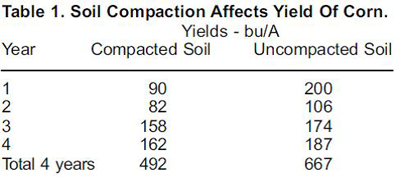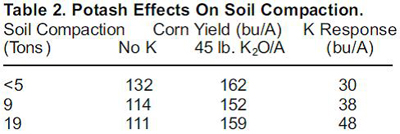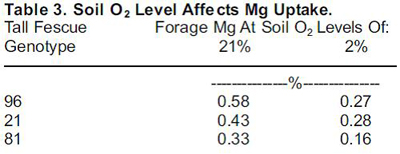Plant experts often say that high yields of good quality crops don’t result from any one factor (such as fertilizer application, or planting the best variety), but to a whole set of effective management inputs, generally defined as “best management practices.” Keeping the importance of best management practices top of mind, it’s instructive to consider the interactions of soil fertility and soil compaction in affecting plant growth.
To begin with, it’s important to understand the highly detrimental effects soil compaction can have on yields — even when all other management practices have been fine-tuned and effectively implemented. Compacted soil layers can markedly restrict root penetration, simply because of increased soil strength. Also, under compacted conditions, water penetration and movement is restricted, oxygen supply is reduced, and carbon dioxide concentration increases. All these factors negatively impact root growth, which ultimately leads to reduced yields. This has been dramatically shown in field trials from Indiana over a four-year period. Soil was initially compacted by several passes with a large tractor. Then corn yields were compared with an adjacent, non-compacted plot. All other inputs were identical for the two plots. Results appear in Table 1.

The percentage yield decrease caused by compaction was 55 percent the first year and was still 13 percent four years after the compaction treatment. Additional studies with soybean seedlings showed that root weight was reduced by 16 percent, and shoot growth by 6 percent solely from the effects of soil compaction.
Soil fertility effects on soil compaction
Good soil fertility can somewhat reduce the harmful effects of compaction. Two nutrients that have received a considerable amount of study in this regard are contained in K-Mag: potassium and magnesium. Studies from Wisconsin showed that application of potash (K₂O) in the row fertilizer (on high-testing soils) helped overcome the effects of compaction (Table 2).

Studies from Indiana showed that applications of K₂O helped overcome many of the detrimental effects of soil compaction. For instance, soil compaction reduced root weight of soybean seedlings to a lesser degree in high-K soils than in low-K soils. Likewise, root surface area was reduced by compaction, but less so in high-K soils than in low-K soils. With regard to magnesium (Mg), research has shown that low oxygen (O₂) levels in soil markedly reduce plant absorption of this nutrient. (Reduced O₂ concentration is commonly observed under compacted conditions.)
Studies with several fescue varieties showed that as O₂ content of soil was reduced to 2 percent (from a “normal” level of 21 percent), leaf Mg content was reduced approximately 50 percent (Table 3).

This indicates that under compacted soil conditions, application of Mg fertilizer might be necessary to prevent deficiencies of this nutrient. Although K and Mg have been used here to show the effects of compaction on nutrient absorption, many nutrients are affected the same way. Actually, absorption of most of the essential nutrients is reduced under compacted conditions.
Although soil fertility will not usually eliminate all the harmful effects of compaction, utilization of a complete, well-balanced fertility program can reduce the severity of these effects.
Other factors
Additional problems associated with soil compaction include restricted water movement. Subsurface compacted layers impede water movement down through the profile. This can lead to waterlogging in surface layers and severely depress growth in general. Conversely, if root growth is restricted to surface layers because of compacted subsurface zones, the detrimental effects of dry growing periods magnify. Also, the mode of action of some herbicides is enhanced under compacted conditions, sometimes to the point of causing herbicide injury.
The most effective way of dealing with all of the problems associated with soil compaction is to adopt cultural practices that reduce or prevent the occurrence of the problem in the first place. The most obvious of these is reducing the number of trips across a field with heavy equipment.
Equally important is avoidance of tillage and harvesting operations when soils are too wet. Nevertheless, some soils naturally tend to develop compacted layers more readily than others. Subsoiling equipment is available to break up or shatter compacted layers, and this is usually an effective technique for restoring productivity to these soils. For instance, in the Indiana field studies mentioned previously, subsoiling to a depth of 18 inches eliminated yield reductions caused by compaction, whereas chiseling to a depth of 10 inches was ineffective.
In summary, adopting effective tillage operations into your best management practice regimen is critical to avoiding the many problems associated with soil compaction. However, when soils develop compacted layers — for whatever reason — developing a carefully planned, well-balanced fertility program is especially important.